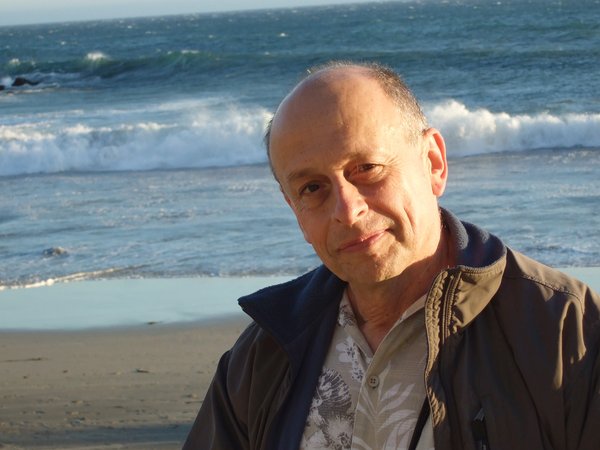A Q&A with physicist David Politzer about solving the mystery of the strong force more than 50 years ago
When David Politzer, the Richard Chase Tolman Professor of Theoretical Physics at Caltech, was a fourth-year student at Harvard in 1973, he made an astonishing discovery that would forever change the field of particle physics. He had been pondering a physics problem and decided to do a long, painstaking calculation to better understand it. By the time he finished, he realized that the formula he had derived had profound implications for another puzzling question: How does the strong force bind the nuclei of atoms together?
Politzer’s calculations revealed that the strong force—one of the four fundamental forces of nature in addition to gravity, the weak force, and electromagnetism—acts differently than the others. The strong force is what holds together the smallest known particles of matter, the quarks, inside the nuclei of atoms. But instead of weakening as quarks move away from each other, as is the case with other forces, the strong force remains very strong.
This phenomenon can be compared to pulling on a string, which has a “quantum-mechanical and relativistic modo,” as Politzer puts it. Inside atoms, these quantum strings bind quarks together. Any attempt to pull the string between the quarks just makes more string. If one pulls hard enough, the string snaps and turns into more quarks. “But the strings are very mobile when the quarks are close together,” Politzer says. This instability means that quarks behave as if they are free when they are very close to each other. From a technical point of view, this phenomenon is called asymptotic freedom.
For the discovery of asymptotic freedom, Politzer won the 2004 Nobel Prize in Physics along with David Gross and Frank Wilczek, who made the same discovery independently of each other. The breakthrough had major implications for quantum chromodynamics (QCD), a theory proposed by the late Caltech professor Murray Gell-Mann in 1972 to describe the strong force. In essence, Politzer’s discovery gave QCD working equations that could be used to calculate the interaction of particles. Gell-Mann, who coined the term “quarks” after a line from James Joyce’s novel Finnegan’s Wakewon the Nobel Prize in Physics in 1969 for suggesting that quarks are the basic building blocks of matter.
“Politzer’s work has changed particle physics more than any other work in the last 50 years,” said Mark Wise, the John A. McCone Professor of High Energy Physics at Caltech and a colleague of Politzer. “This allowed physicists to quantitatively understand many processes that before 1973 were incomprehensible. This includes processes that are relevant to physical questions beyond the strong interactions themselves, such as the discovery of the Higgs boson at the Large Hadron Collider.”
We sat down with Politzer to learn more about the roots of his far-reaching discovery.
Were you interested in physics at an early age?
My big brother, six years older, went to Bronx Science, a magnet high school in New York, and then to MIT. He did real physics and good experiments. He clearly said that cool guys do physics and I caught the mistake from him. I also went to Bronx Science, riding the subway from Manhattan with friends for an hour each way. One summer, towards the end of high school, I wanted to apprentice with a banjo master. I had just built a banjo. So I wrote to a banjo maker in Colorado, but he decided he was done with folk, sold his business, and never got back to me. I ended up going to college instead at the University of Michigan and loved it. I got as many B’s as A’s in physics and math. But I loved working in research labs.
What was known about the strong force and quarks when you were in graduate school?
In the mid-1960s, Murray Gell-Mann invented the “Eightfold Way,” in which three kinds of quarks combine in different ways to make the strongly interacting particles known as hadrons [which include protons and neutrons]. Some days he thought quarks were just mathematical contraptions that let you see patterns, and other days he thought they were a physical reality. That was the theoretical side of things. Experiments are also done that do not fit the theories. One of the most famous experiments took place at SLAC [a federally funded particle accelerator operated by Stanford University] in 1968 and led to confusing results that became known as the Gee Whiz plot because every time someone saw the plot, all they could say was “gee whiz.”
In this experiment, electrons were accelerated to high speeds and bounced off some kind of fixed target. The electrons bounced back as if they hit something very hard and with a lot of momentum inside the protons. Of course, we now know that electrons hit quarks and the process generates new particles. Richard Feynman [who, before Politzer, was the Richard Chace Tolman Professor of Theoretical Physics at Caltech] had his own theory of what was going on and didn’t believe Gell-Mann quarks had anything to do with it. The two would make fun of each other for it.
Did you do any quark research yourself at that time?
Earlier, as a freshman, I worked on an experiment known as the evaporation of oysters. This is completely true. We knew it must be difficult for a quark to exit the nucleus on its own because we had never seen it happen and still don’t to this day. High-energy cosmic rays come from the sky and strike the ocean. What happens if they remove quarks from atoms? We were looking for evidence of the fractional charges of quarks. The idea was that wherever the quark landed, it would have a net charge. So maybe it’s in the seawater, maybe it’s in the salt, maybe it’s in the algae. Things become biologically concentrated. There was a barrel of oysters and we steamed them too. We passed the steam between the charged plates and tried to concentrate the partial charge. Well, we’ve never seen a quark. But there was a reason to eat a lot of oysters.
How did you get involved in the power problem?
I haven’t started working on this problem. In graduate school at Harvard, a friend of mine and I traveled to New York in my car to go to a conference. We talked about physics the whole way. I thought of a question related to his project with our professor Sidney Coleman [PhD ’62]. I asked Coleman about it later and he said, “That’s really interesting. Do you mind if I work on it with you?” We never got very far, but I learned a lot. One calculation I tried for this project didn’t help, but it turned out amazing for the strong force question.
At the time there was something called the Weinberg-Salam model that described the weak force and how it was intertwined with electromagnetism. This model is what we call non-Abelian gauge theory. It’s a lot like electromagnetism, except there are several different kinds of charge instead of one electric charge, and they add up in a funny way. Physicists wanted to apply the same kind of theory to the strong force, but weren’t sure how to put it into equations. Meanwhile, in 1971, a Dutch student named Gerard ‘t Hooft [formerly the Sherman Fairchild Distinguished Scholar at Caltech in 1981] he had done the math and made it work. At first, no one paid much attention to this. Another one of my professors at Harvard, Shelley Glashaw, gave me a copy of the report and said, “This guy is either a genius or crazy.” Gerard ‘t Hooft’s solution was very idiosyncratic and virtually impossible to follow, but his mathematics had corrected the problems with infinities in the Weinberg-Salam model. He made the equations kosher.
Anyway, this mathematical framework is what I turned to at some point in my own research on a non-strong force problem. The first thing I did was a simple but tedious calculation related to non-Abelian measure theories. These days the calculation is homework for physics students, but back then it took several days by hand on paper. I soon realized that the results meant that something called the beta function for the strong force had a minus sign. This essentially means that the effects of the strong force, unlike those of the other forces, become smaller as the quarks get closer. This is asymptotic freedom. I figured that would make the Gee Whiz storyline work. I did the calculations over and over and got the same answer.
Did people immediately believe your result?
I sent a draft of the paper to my advisor, Sidney Coleman, and he didn’t believe it. By the way, I nominated Sidney for the Caltech Distinguished Alumnus Award because he was a great teacher with influence in the particle physics community, and he won. Anyway, because of him the title of the paper “Reliable perturbative results for strong interactions?” there is a question mark, which I now regret years later because I knew the calculation was correct.
Murray Gell-Mann immediately understood what the calculation meant—that his QCD theory was not hypothetical. This meant that the possibility of performing accurate calculations within this theory opened up immediately. Feynman was skeptical, and it took him several years to realize that some experiments he thought contradicted QCD actually agreed. He had to wait for the lessons of higher energy collisions. Everything comes together at higher energies.
What were the wider implications of your calculation?
When I entered graduate school, particle physics was a mess. There was a lot of experimental and theoretical stuff in the field that was interesting, provocative, exciting, mutually contradictory. By the time I graduated, there was a standard model that worked, accurate predictions you could make, and experiments you could do. As my colleague Mark Wise said, the state of particle physics changed completely once the mystery of the strong force was finally solved.
What is your favorite part of doing research, both in fundamental physics and in your more recent stringed instrument research?
As for me, I like to understand how something works. This is great. Now, whether other people already know it doesn’t change the feeling of figuring it out yourself. They may tell you and you may not understand them and that happened to me. But there is joy in figuring it out for yourself.



